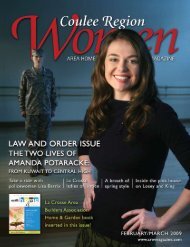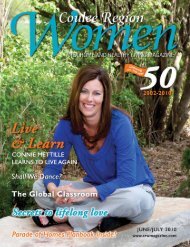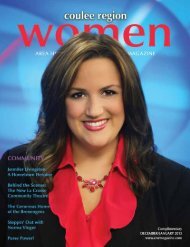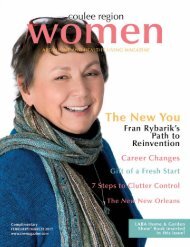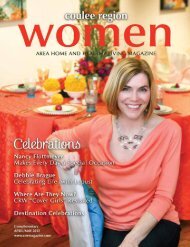October/November - Coulee Region Women's Magazine
October/November - Coulee Region Women's Magazine
October/November - Coulee Region Women's Magazine
You also want an ePaper? Increase the reach of your titles
YUMPU automatically turns print PDFs into web optimized ePapers that Google loves.
| HERSTORY | FOOD |<br />
Beyond the Bakery Aisle<br />
Eating gluten-free is key to health for individuals with celiac disease.<br />
by Shari Hegland<br />
Contributed photos<br />
Recipes analyzed by Gundersen Lutheran registered dietitians<br />
For nearly 20 years, Mary Lou Balts has lived without wheat,<br />
rye, barley or any of their derivatives. It can be a difficult undertaking,<br />
but it is becoming easier as grocers and restaurants meet the needs of<br />
the growing population who must avoid gluten—a protein found in<br />
those popular grains.<br />
It took months for the La Crosse nurse and her doctors to find the<br />
cause of her drastic weight loss, lethargy and embarrassing symptoms<br />
that required being near a bathroom at all times. The diagnosis: celiac<br />
disease, an autoimmune disorder in which the body’s reaction to gluten<br />
damages the lining of the small intestine, responsible for nutrient<br />
absorption. “Basically, I was starving to death. I was malnourished,”<br />
she says.<br />
A “huge challenge”<br />
Discovering the cause was a relief, but it also offered a huge challenge.<br />
The only treatment for celiac disease is complete avoidance of gluten.<br />
Sound easy “I went through the grocery store for three hours,” Balts<br />
says, “and picked up six items.<br />
“There is so much hidden gluten, we get to be very good label<br />
readers,” she says. While wheat is sometimes clearly identified on food<br />
labels as a possible allergen, rye and barley are not always as easy to spot,<br />
and oats may be cross-contaminated during harvesting and processing.<br />
Wheat turns up as coatings on medications and in modified food starch<br />
used in many processed foods. And, of course, it is the primary flour in<br />
breads, cakes, cookies, cereal, crackers and pasta.<br />
Research and creativity<br />
In the last two years, Tracie Happel and her two teenagers are also<br />
becoming masters at reading ingredient levels, but they don’t let their<br />
gluten-free diet keep them from being active. “All it is, really, is getting<br />
rid of bread and pasta products, so we eat more vegetables and fruit<br />
and chicken,” she says. Of course, there are also times when gluten<br />
turns up in the most unexpected places. The Onalaska teacher, who<br />
competed in her fourth Ironman triathlon in September, has learned<br />
the hard way, midrace, that some flavors of Gatorade contain gluten<br />
in the form of modified food starch.<br />
“I know within 10 minutes if I have something with gluten,” she<br />
says, due to swelling in her fingers and toes and a tingling feeling.<br />
While a growing selection of gluten-free products is available from<br />
local grocery stores and specialty shops, it can be a challenge to make<br />
the transition. Happel and her children have yet to find “sandwichworthy”<br />
bread for their lunches or her favorite workout treat of peanut<br />
www.crwmagazine.com OCTOBER/NOVEMBER 2011 41



